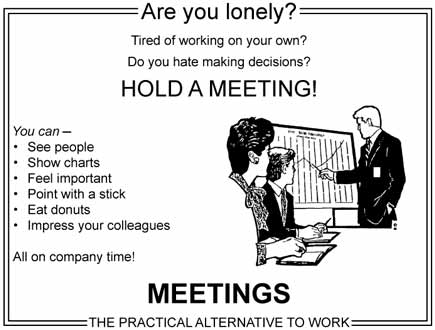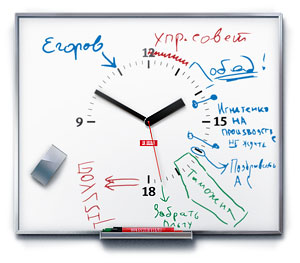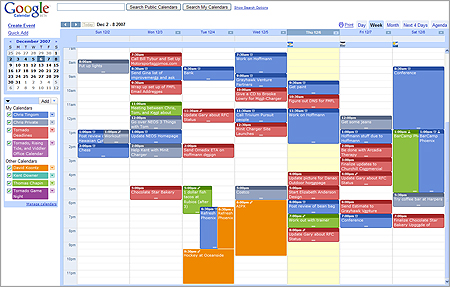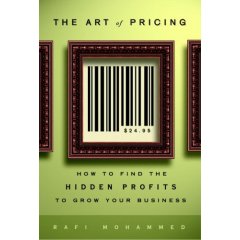For all of you folks who work at home in solitude:

The best time tracking software reviews and methods
For all of you folks who work at home in solitude:

Here is a really clever clock which has more than 150 analog hands. Each hand rotates and spells out the hour of the day. In the example photo below, the four is visible. Click here to watch an animation of how it works.
I’ve been thinking about the next generation web design studio quite a bit lately. What makes a team efficient? How can small teams maximize efficiency?
Bob Parsons who runs Go Daddy has written about tracking and measuring important business numbers. I read this and said “yeah, I need to do that.”
One thing I learned early in my business career is that anything of significance that is measured and watched, improves.
Back before I started Parsons Technology I became impressed with something I read about John D. Rockefeller. In fact, I still think about it and use it to this very day. I learned that Mr. Rockefeller was one of the few people in his industry (perhaps the only one) who knew exactly how much it cost to extract, refine and deliver a barrel of oil. In fact, he was entirely aware of all his costs. Knowing this information (and acting on it) gave him a huge competitive advantage. He knew how much he could price a barrel of oil for and still turn a profit. He was always keenly aware of each area of revenue, cost and market share, and he worked on improving in every area. As a result, he did cost saving things like manufacture his own oil barrels, have his own cartage company, and on and on.
The first sentence is the most important. Read it if you skipped over it.
This all brings me to my point. I think it’s very important to track the numbers that make your business a success. I’ve tried to do this over the years and have tracked a large number but never to the extent I want (for numerous reasons, not that I didn’t try).
As I said, I’ve been thinking about the next generation web firm and wondered what numbers you track in your business or where you work? The obvious things like revenue and billable hours are obvious, the less obvious are things like average employee utilization across a period of time, or average timespan to develop a site… How does this affect the bottom line? Does it give you a competitive advantage? I’ve got loads of ideas about things that can be tracked. Putting systems in place to actually track them (consistently) is the next step.
 On Saturday morning I packed up my camera and went to a little open house a friend of mine was throwing. It was a great time and of course I got to take pictures with my flash. There were a bunch of new people there that I had never met, and one guy in particular caught my attention.
On Saturday morning I packed up my camera and went to a little open house a friend of mine was throwing. It was a great time and of course I got to take pictures with my flash. There were a bunch of new people there that I had never met, and one guy in particular caught my attention.
After asking the two key questions people ask (where do you live and how do you know so and so) someone asked what he did for a living. He said he worked for the city. Then he commented that it was the safest job in the world and said that he would probably have to murder someone in order to get fired.
Maybe it’s time that our cities adopt the GE management idea and regularily trim the bottom 10% from their workforce.
One of the first things I thought about was the idea that “safe” means different things to different people. To this guy, safe means a steady paycheck and benefits. And I suppose he won’t have to dust off his resume too often.
To me, a safe job means that I’m in control of how much money I can make. That doesn’t always mean I get to pick when I work, but ultimately I am in charge.
So this got me thinking. Is there a way to combine both of these worlds. I think that profit sharing plans are a start, however I like some of the things that Semco does in Brasil. They basically put people in charge of their salary along with the ability to hire and fire their managers. Since their co workers can also vote to remove someone, there’s a lot of incentive to be fair.
I know that not everybody is in a position to introduce plans and systems like this, but I think it’s wise to consider and aim towards that goal. The trick always comes down to whether the people on your team have an owners mentality.
What’s the point of this post? Well, I just read a fun article called 10 Reasons You Should Never Get a Job. I have been approaching my business with this model recently. Building up an all-service business is hard because you have to spend time in order to earn money. That’s why I’m slowly moving into ideas that earn residual income. It’s not easy but everything has much greater potential.
And that’s really what it’s all about.
Our product has had a few names during our development process. Picking a name for a product is incredibly tricky. Not only do you need to come up with a good name that everyone likes, but you have to find the domain name.

Previously, the product was called Roundup, and before that Windstorm.
Now, we’ve come up with a name we’re happy with. It’s Minuteglass. It’s like “hourglass” but for minutes. Get it? We like it and we’re working on logos and also working on the product. We’ve got more people on the team, so the product is coming together faster.
We just launched a site called TimeTrackingResources.com which is a list of great time tracking software and web services. We’ve researched our future competition and studied the features people want the most.
We realize that not everyone will find our software to be perfect for their uses. So check out this new web site and we hope you find something that works for you!

A whiteboard with a clock built into it. Such a simple and grand idea! If you’ve ever been the unhappy participant of a 4 hour long meeting, this is for you! Unfortunately, I don’t know if the product is for sale. It was first released in 2004 and I couldn’t find it for sale online.
Thanks to Brian Shaler for the tip.
We’re fast becoming fans of Twitter — the coolest social network we’ve seen. If you’re on Twitter, feel free to follow us and learn what we’re up to!

Follow Minute Glass: http://twitter.com/MinuteGlass
Follow Chris: http://twitter.com/christingom
 Tornado will have a presence at SXSW this year. We’ve wanted to go for years but always been so busy with client work. This year, we’ve decided to go anyways! We’ve bought our tickets and everything.
Tornado will have a presence at SXSW this year. We’ve wanted to go for years but always been so busy with client work. This year, we’ve decided to go anyways! We’ve bought our tickets and everything.
So who’s going? Chris Tingom and Thomas Chapin. If you’re going to be there this year, and would like to meet up, just give us a shout. Thanks.
Facing the Giants is a movie about football and this inspirational clip will inspire you to do your best and never give up on your goals.
Payment gateways have the most confusing web interfaces. There’s no consistency among systems, and most of them look like they were designed by an 8 year old.
As I was configuring viaKLIX for a customer, I stumbled across this great feedback form. They actually have an option for “confusing interface.” How appropriate.

This is a classic case of a company seeing a problem and applying a band-aid to the problem, and never fixing the root problem. In this case, a confusing interface.
Seth Godin, a marketing wizard who has written many books I admire, says this about band-aid marketing: Every quarter, your company ships new products or services. And every quarter, someone says, “under the circumstances,” or “given the deadline” or “with the team we had available”… it’s the best we could do. I say ship nothing.
Good advice.
Launchy for Windows is the program that helps me save 10 minutes every single day. I use it to launch programs and to pull up folders on our network. The best part: it’s free (and open source!). Now is a great time to try this program as they just released version 2.0 with tons of improvements.

Quicksilver for OS X is the Mac equivalent and is just as good and available for free.
I promised to talk a little bit about the different ways people track time. Today, I am going to give you a brief explanation of what ice core dating is all about, and why scientists think it’s useful.
When scientists drill an ice core they pull a very large sample of data. Similar to the rings on a tree, ice cores have layers and it is possible to tell each annual layer apart. Water evaporates at different speeds depending on the outdoor temperature. It’s actually possible to see this in the samples. The other method is through Irradiation Dependent Markers (cosmic rays and solar irradiation impinging on the upper atmosphere).
It’s really all too complex to describe here, I suggest further reading:

I’m not perfectly organized. I’m probably a bad example of organization. But at work, I like to think I am organized.
1. Time Tracking: I track all of my time at work religiously. I know exactly what I was doing and when on any day this year (billable and non billable work). We currently use Complete Time Tracking Pro for time tracking, but are working on our own time tracking system called Minuteglass.

2. Calendar: I organize my days with Google Calendar. In our office, we have a “Tornado Deadlines” calendar so any time we promise a client something it’s added.

3. To-Do-Lists: We use Todoist for tracking our to do list. We have a separate category for every one of our customers and share it in our office. Everyone knows what items are due today and in the next two weeks.

4. Email: In Outlook, I flag emails that need to be responded to. Only after that is completed, added to our Todoist task list do I unflag it. Or when the email is responded to.

What other tools do you use for tracking your life? There are so many ways to track projects and time and money. We’re working on a few that we will be releasing as well.
The good news is that everyone in our office uses these same tools (team of 3 people). This makes collaborating that much easier!
Update: In January, 2011 we use Gmail a lot more, still use Todoist.com, and also use a number of tools across the Mac and PC platform.
Update 2: In August, 2013 my main tools are: Harvest (using the Mac app), Wunderlist for to-do list, Sparrow for email, and Google Calendar for my calendar. I also started using Evernote for keeping track of docs and client files, and use Dropbox for storing client projects.
I ran across this great picture on Reddit this evening. I just had to pass it along. It’s really a fitting extension to my article I posted in July.

Source: Flickr
Article: U.S. Currency and the Pictures Behind The Portraits
“It has been my observation that most people get ahead during the time that others waste.” — Henry Ford
After I don’t know how many months of stalled progress, we made some today. Sometimes getting a project off the ground that isn’t funded, is difficult. Paying clients always tend to get the preferential treatment — mostly because they have a very real deadline, that you can’t ignore.
We’re really excited about our project and believe we have a truly innovative idea. We’re using the approach: “Get a product launched and improve it constantly.” Anyways, we made quite a bit of headway today and I just had to share.

Simply enter your monthly salary and this tool will show you how much money you are earning in real time. It’s fun and could be depressing all at once. Click here to give it a try.
 Figuring out the price of products is so hard. Should you charge $5.95 for a product, or $10.95? Their are so many different areas that this will impact — for one, the survival of your company!
Figuring out the price of products is so hard. Should you charge $5.95 for a product, or $10.95? Their are so many different areas that this will impact — for one, the survival of your company!
I was rather pleased to stumble upon a book about pricing at Borders. It is called The Art of Pricing: How to Find the Hidden Profits to Grow Your Business. At first I thought “what can be learned from a book about pricing?” but I was rather surprised.
The book uses many real-life examples. There are stores about how Ford lowered prices on higher margin products to encourage less sales of lower margin products. As a result, they significantly increased sales of premium upgrades because the value was greater.
Similarly, a restaurant example showed how you could attract different types of customers using “early bird discounts” to attract penny pincers but limiting those to sales to times when foot traffic was lower.
This is a great book that gives ideas and examples to help you price your products or services. But more than that, it gives you creative ideas for pricing that you might not think about and that could prove extremely profitable.